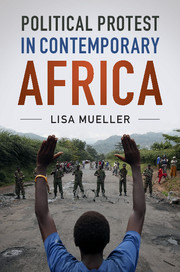Book contents
- Political Protest in Contemporary Africa
- Political Protest in Contemporary Africa
- Copyright page
- Contents
- Figures
- Tables
- Preface and Acknowledgments
- 1 Introduction: The Puzzle of Africa’s Third Wave of Protests
- 2 Defining Africa’s Protest Waves
- 3 Paradoxes of Prosperity
- 4 Comparative Protest Leadership:
- 5 Comparative Individual Participation in the Third Wave
- 6 Not-So-Great Expectations: Pessimism and Protest in Niger
- 7 Conclusion
- Book part
- Bibliography
- Index
- References
Bibliography
Published online by Cambridge University Press: 11 June 2018
- Political Protest in Contemporary Africa
- Political Protest in Contemporary Africa
- Copyright page
- Contents
- Figures
- Tables
- Preface and Acknowledgments
- 1 Introduction: The Puzzle of Africa’s Third Wave of Protests
- 2 Defining Africa’s Protest Waves
- 3 Paradoxes of Prosperity
- 4 Comparative Protest Leadership:
- 5 Comparative Individual Participation in the Third Wave
- 6 Not-So-Great Expectations: Pessimism and Protest in Niger
- 7 Conclusion
- Book part
- Bibliography
- Index
- References
- Type
- Chapter
- Information
- Political Protest in Contemporary Africa , pp. 213 - 260Publisher: Cambridge University PressPrint publication year: 2018

